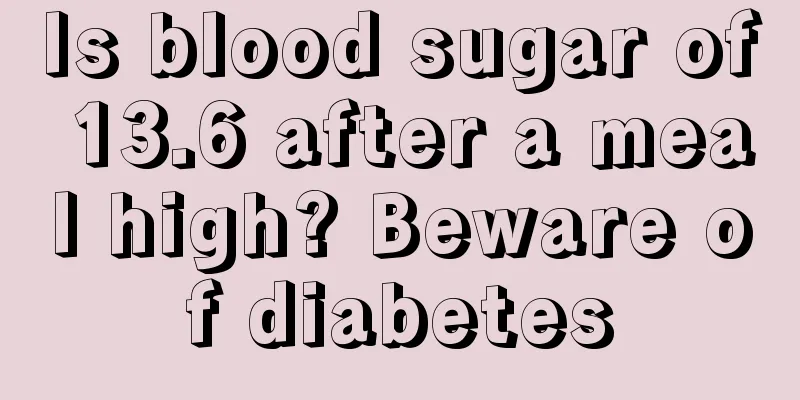Is blood sugar of 13.6 after a meal high? Beware of diabetes

|
A blood sugar level of 13.6 after a meal is already too high. If the blood sugar level after a meal is high for a long time, it will be very harmful to diabetic patients. Blood sugar level after a meal must be controlled in time. Therefore, special attention should be paid to diet. The intake of high-sugar foods should be strictly controlled, more whole grains should be eaten, and no greasy foods should be eaten. 1. Is blood sugar level of 13.6 after a meal high? For a normal person, the whole blood glucose level should not exceed 5.6 mmol/L (100 mg/dL) and the plasma glucose level should not exceed 6.4 mmol/L (115 mg/dL) 2 hours after a meal. If the whole blood glucose level 2 hours after a meal is ≥7.8 mmol/L (140 mg/dL) and the plasma glucose level ≥8.9 mmol/L (160 mg/dL), diabetes can be diagnosed. 2. Suggestions to help maintain stable blood sugar levels after meals. 1. Control the total carbohydrate intake. The food categories should be diversified, but the staple food should be reduced when eating potatoes, sweet potatoes, yams, and fruits. 2. Strictly control refined rice and refined flour. Such as white bread, white rice, white steamed buns, etc., it is best not to exceed 1/3 of the staple food every day. Eat less sticky starch foods such as glutinous rice, rice cakes, Yuanxiao, and rice dumplings. 3. Replace white rice and flour with whole grains, beans and potatoes, or mix them with white rice and flour and cook them. Soybeans, black beans and soy products are not grains, they can only replace meat; while starchy beans such as red beans, mung beans, kidney beans, etc. can partially replace staple foods. 4. Eat 1 kilogram of vegetables every day. Green leafy vegetables should account for at least half of the meal, and they should be cooked with less oil to help resist hunger. 5. The daily oil consumption per person should be controlled within 25 grams. Excess fat can reduce insulin sensitivity. 6. Do not cook for too long, the food should not be too fine or too soft, and the food should be chewy enough. 7. Eat staple foods in small bites and chew more frequently. Eat a small bite of your main meal, pair it with a protein-rich food, and have two or three bites of vegetables. The slower you eat staple food, the slower glucose enters your blood. 8. Eat nuts with meals. Nuts can provide vitamin E and dietary fiber, but the amount should be controlled. Choose non-fried and low-salt products and eat them during meals. Nuts can help promote satiety and slow down the rise in blood sugar. |
<<: Rheumatoid spondylitis, symptoms at different stages
>>: What causes low thyroid hormone?
Recommend
How to check blood in stool
The stool of a normal person is generally light y...
Are birth control pills effective in removing acne?
Everyone wants to have fair and smooth skin, but ...
How can obese men prevent prostate cancer
Prostate cancer is now a disease with an increasi...
Is it good to wash your face with toothpaste?
We all know that toothpaste is used for brushing ...
Will breast cancer cause dizziness and nausea?
Once breast cancer patients experience dizziness ...
What are the methods of making red beans
Red beans are brightly colored and have high nutr...
Why do my thighs itch when running?
As people's health awareness increases, many ...
What is the reason for the redness of fingertips
The phenomenon of red fingertips occurs occasiona...
What do you need to do to prevent bone cancer
What should we do to stay away from bone cancer? ...
How should pancreatic cancer be treated
How should pancreatic cancer be treated? Pancreat...
What medicine should I use for skin cancer ulcers
Skin cancer is a malignant tumor of the skin, a v...
Can I eat garlic if I have stomach acid? It turns out to be like this
Gastric acid is a common phenomenon in life. Many...
6 signs reminding you to protect your liver
Symptom 1: Increased acne The progesterone hormon...
Complications of rabies
Any disease will cause some complications, and th...
What diseases can bladder cancer cause
Bladder cancer not only causes great harm to the ...









